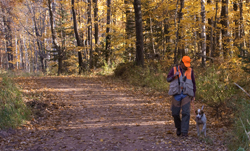Hazards in the grouse woods
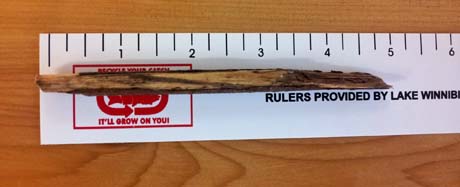
This broken stick was embedded deep in the back of the mouth and into neck tissue of Northwoods Grits when he just a puppy. Our vet expertly removed the stick and Grits recovered perfectly.
The grouse woods are a tough place for a bird dog to work. Big, rotting logs and downed tree limbs are scattered everywhere. Young aspen cuttings and stands of hazel are tight and can be almost impenetrable and swamp edges can be thick with alders. Dogs must be nimble and be able to react quickly for they are constantly jumping over, ducking under and pushing through some sort of obstacle. Other hunting cover types such as field edges, wide open deserts and mowed pine plantations seem tame in comparison.
Grouse dogs have to make their own way in the woods and in addition to being physically demanding, it’s often hazardous.
Our dogs have run into plenty—from mere scrapes and bangs to some very serious situations—but (knock on wood), Betsy and I have yet to lose a dog. Listed below, in alphabetical order, are the hazards we’ve encountered and what we do. Our advice is based on years of experience and guidance from our veterinarians, so much so that we’re now able to handle many of the problems ourselves. When in doubt, though, please go to a vet and go quickly. Often, time is of the essence.
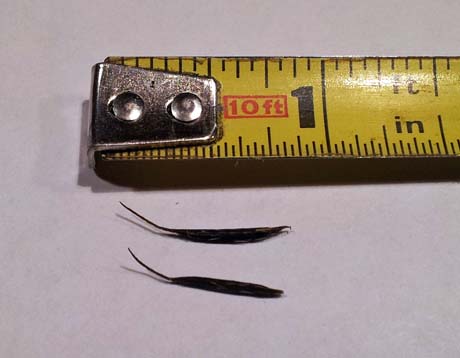
All manner of seeds–some even quite long–can enter a dog’s eye and cause problems.
Eyes: debris
Seeds and other debris often get in the corners of the eyes and sometimes under the eyelids. One of the worst culprits is a long, black seed that can get under the third eyelid and cause serious abrasion.
What we do: After each session, we rinse the eyes with sterile eye wash. A dampened Q-tip can be carefully run along the inside bottom of the eye to remove stubborn debris. If a dog develops matter in its eyes or reddened lower lids, we apply Terramycin (non-steroidal, antibiotic ophthalmic ointment) twice a day for 3-5 days.
If a dog paws at its eye or keeps the eye partially closed, something more serious is usually going on. Get the dog to the vet as soon as possible.
Warning: Never apply steroidal eye ointment on a dog’s eye without consulting a vet.
Eyes: fur worn off underneath
Certain, hard-driving dogs that would rather go through things than around are prone to wearing off the fur under their eyes. A secondary problem occurs when the area bloodies and scabs over.
What we do: Vaseline applied carefully (avoid the eyes) works fairly well for protection but usually the problem recurs especially if early in the season. Pace the dog’s time in the woods.
Eyes: scratches
Occasionally, debris, seeds or sticks can actually scratch the cornea.
What we do: Some are small enough to heal themselves with assistance from Terramycin (non-steroidal, antibiotic ophthalmic ointment) applied twice a day for 3-5 days. But if the dog paws at its eye or keeps the eye partially closed, get the dog to a vet as soon as possible.
Warning: Never apply steroidal eye ointment on a dog’s eye without consulting a vet.
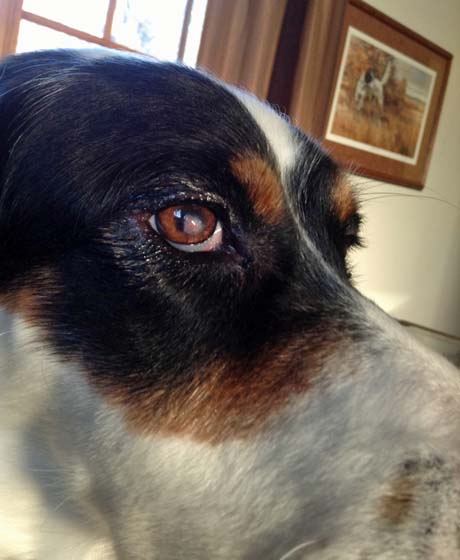
The damage to the right eye of Northwoods Rob Roy was caused by an infection that entered through a small scratch. The spot should slowly shrink so it’s barely noticeable.
Eyes: weird bacterial infection
Last fall, our six-month-old setter puppy Northwoods Rob Roy received what everyone thought was a simple scratch on his eye while hunting in north central Wisconsin. But some sort of bacteria entered the eye via the scratch and, within 24 hours, the situation grew very serious. An infection developed that basically ate away the eyeball until his eye was in danger of bursting. With hourly applications of antibiotic drops and miraculous assistance from Chris Bye and Dan Stadin, we kept Roy quiet until our vet performed a complicated corneal graft surgery. The surgery was successful but Roy is still on eye drops and will always have a small, grayish spot on his cornea.
Lesson learned: Be extremely vigilant of seemingly minor injuries.
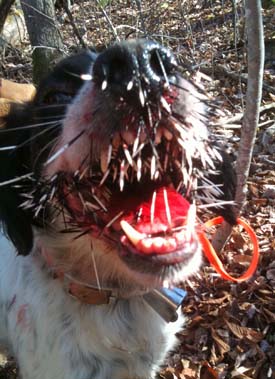
Randy got an mouthful of porcupine quills.
Porcupine quills
Betsy and I have been fortunate to have few problems with porcupines but I’ve seen bad ones. Sometimes a dog (usually males…pointer males are the worst) will actually hunt for porcupines. A lot depends on the dog’s temperament and its first encounter. If the result is just a few quills, it usually doesn’t develop into an issue. But if the dog gets a mouthful because it’s trying to kill the porcupine, the problem can be life-long.
What we do: For just a few quills and a cooperative dog, remove the quills with a Leatherman tool or hemostat. Be careful to get them all and don’t break any. Quills left in the dog can migrate around the body and exit through the neck, jaw and eyes. If in doubt, get the dog to a vet to check for remaining quills. For a bad encounter, get the dog to a vet.
Scrapes: belly and inner thighs
Grasses, ferns and thorns can scrape the belly and inner thigh area and sometimes cause a secondary problem of small pustules. This is more common on certain breeds (pointers) and under certain conditions (early season or open fields and meadows).
What we do: Apply Bacitracin (first aid antibiotic ointment) and rest the dog.
Scrapes: knuckles and forelegs
Gear on the neck—whether ecollars, tracking collars, beepers, bells or Garmins— can hang too low, be too big or be too much. It can also be a matter of mechanics, i.e., a dog that runs with a low head and/or raises its front legs.
What we do: Make adjustments to the neck gear. Try switching from a bell to a beeper, place the bell on top of the neck and/or have the gear ride higher on the neck. Or use less gear.
Scrapes: legs
Grasses, ferns and thorns can abrade fur and/or scrape legs. Foreleg (where the legs meet the chest) abrasion is caused by running through tall grass. Again, both are more common on certain breeds (pointers) and under certain conditions (early season or open fields and meadows).
What we do: Apply Bacitacin (first aid antibiotic ointment) and rest the dog.
Scrapes: wrists
The wrists are the part of the leg above and behind the pad. Abrasions and scrapes to this area are caused by woody stubs, thick brush, etc.
What we do: Apply Bacitracin (first aid antibiotic ointment) or EMT gel and rest the dog.
Seeds
Some grass seeds can be ingested through the mouth as the dog pants or enter the body through the skin. The most dangerous seeds have small barbs that allow them to penetrate farther as muscles and skin contract. These seeds can become encapsulated near the skin surface and cause localized swelling, or worse, can migrate into the body cavity.
What we do: Be vigilant about masses near surface, especially at the end of the rib cage. All of our dogs that developed such a mass required a trip to the vet.
Sticks and other foreign stuff
Betsy and I have had several dogs get a puncture-type wound in the pad, foot and ankle area from sticks and stiff weeds. Dogs can also drive stuff into other body parts, such as mouth, nose, neck, throat and chest. While these are rarely life threatening, I’ve had two very close calls.
One of my first setters, Patch, got a stick in his neck. When I pulled the stick out, blood immediately gushed out. So I stuck my finger over the hole and hurried to a vet.
More recently, Northwoods Grits somehow got a five-inch stick embedded deep in his mouth and into his neck. I couldn’t see anything at first but when I checked later in the evening, he was definitely not feeling well. Wayne, a physician/friend/guiding client, felt what turned out to be the end of stick. We rushed him to the vet. Amazingly, no surgery was required; the vet simply sedated Grits and pulled the stick out.
What we do: All but the most obvious of these injuries will require a trip to the vet.
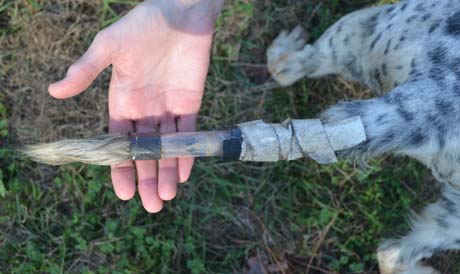
One ingenious method to protect a broken tail is an empty plastic syringe case.
Tails: broken
Broken tails are an uncommon occurrence. The break usually occurs about ¼ to 1/3 from the tip and results in a slightly bend at the break. The fracture can be felt by very gently palpating the bent area.
What we do: While some breaks heal on their own with no long-term problems, we advise a trip to the vet. Our vets have successfully set severe breaks. One ingenuously covered the broken area with an empty syringe case. The difficult part is keeping the tail relatively quiet for 4 – 6 weeks.
Tails: fur worn off, bloody
Some breeds (pointers) and some dogs (very active tail…carried just so) are prone to wearing the fur off the tip of the tail. Eventually the skin becomes thin and the tail bleeds.
What we do: This is a tough one. Apply EMT gel for protection before heading into the woods. To help heal the area after hunting, apply more EMT gel. We’ve tried several methods of taping—all with limited success because tails move so much. Dave Hughes, pro grouse dog trainer, developed a method that worked fairly well for later in the season and/or if the tail was in bad shape. From the tip to just above the base, wrap loosely with masking tape. Then wind electrical tape in a candy-cane design over the masking tape. Be very careful when taping so there’s not too much weight or the tape isn’t too tight.
Tick-borne diseases
An entire post could be devoted to this subject as it is complicated and generally in flux as new discoveries are made. Here is the pertinent information…currently.
Lyme disease (caused by bacteria Borrelia burgdorferi sensu lato), ehrlichisos (caused by bacteria in the genera Erlichia), anaplasmosis (caused by bacteria in the genera Anaplasma ; very confusing taxonomy between Erlichia and Anaplasma with continual changes by the scientific community), babesiosis (caused by protozoa Babesia microti) and other tick borne diseases yet to be identified are a major problem in certain parts of the country.
One fall, several dogs in our kennel become symptomatic but nothing could be identified (even by Marshfield Labs!). Common signs of the diseases are lameness in one or more legs caused by joint pain or muscle pain, high fever (often over 104), intermittent elevated fever, loss of appetite and, depending on the specific disease, nausea and vomiting.
What we do: We administer the antibiotic doxycycline for 30 days. Within a day or two, the symptoms disappear. If a dog is under nine months of age, consult a vet about the correct antibiotic to use since doxycycline can cause problems with teeth in puppies.
Torn dew claws
Betsy and I think this is an extremely uncommon and overrated problem. In fact, for many reasons, we don’t remove dew claws on tiny puppies anymore. We’ve had less than a handful of these injuries and none was serious.
What we do: Clip off any remaining part of the nail and disinfect daily Bacitracin (first aid antibiotic ointment). Rest the dog for a day or two.




